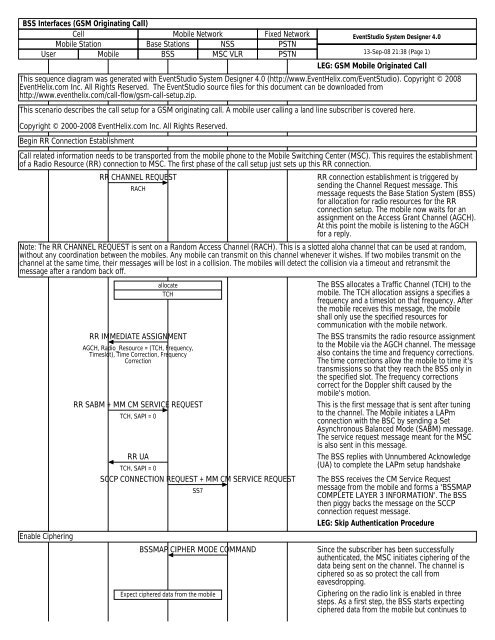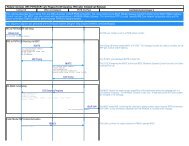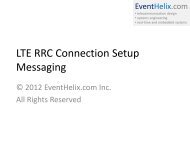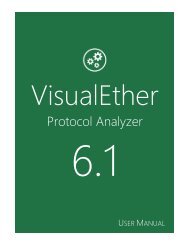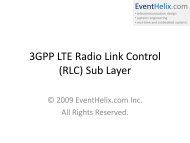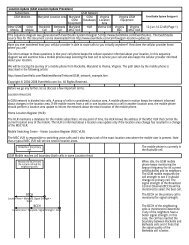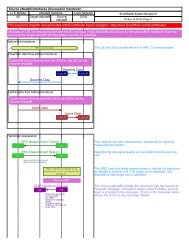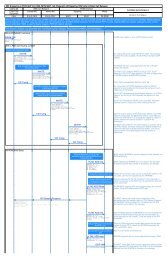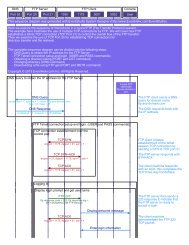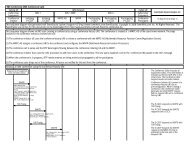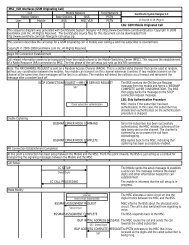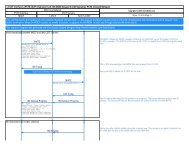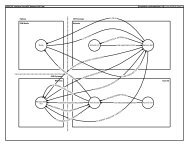BSC Call Flow - EventHelix.com
BSC Call Flow - EventHelix.com
BSC Call Flow - EventHelix.com
Create successful ePaper yourself
Turn your PDF publications into a flip-book with our unique Google optimized e-Paper software.
BSS Interfaces (GSM Originating <strong>Call</strong>)<br />
Cell Mobile Network Fixed Network<br />
Mobile Station Base Stations NSS PSTN<br />
User Mobile BSS MSC VLR PSTN<br />
EventStudio System Designer 4.0<br />
13-Sep-08 21:38 (Page 1)<br />
LEG: GSM Mobile Originated <strong>Call</strong><br />
This sequence diagram was generated with EventStudio System Designer 4.0 (http://www.<strong>EventHelix</strong>.<strong>com</strong>/EventStudio). Copyright © 2008<br />
<strong>EventHelix</strong>.<strong>com</strong> Inc. All Rights Reserved. The EventStudio source files for this document can be downloaded from<br />
http://www.eventhelix.<strong>com</strong>/call-flow/gsm-call-setup.zip.<br />
This scenario describes the call setup for a GSM originating call. A mobile user calling a land line subscriber is covered here.<br />
Copyright © 2000-2008 <strong>EventHelix</strong>.<strong>com</strong> Inc. All Rights Reserved.<br />
Begin RR Connection Establishment<br />
<strong>Call</strong> related information needs to be transported from the mobile phone to the Mobile Switching Center (MSC). This requires the establishment<br />
of a Radio Resource (RR) connection to MSC. The first phase of the call setup just sets up this RR connection.<br />
RR CHANNEL REQUEST<br />
RACH<br />
RR connection establishment is triggered by<br />
sending the Channel Request message. This<br />
message requests the Base Station System (BSS)<br />
for allocation for radio resources for the RR<br />
connection setup. The mobile now waits for an<br />
assignment on the Access Grant Channel (AGCH).<br />
At this point the mobile is listening to the AGCH<br />
for a reply.<br />
Note: The RR CHANNEL REQUEST is sent on a Random Access Channel (RACH). This is a slotted aloha channel that can be used at random,<br />
without any coordination between the mobiles. Any mobile can transmit on this channel whenever it wishes. If two mobiles transmit on the<br />
channel at the same time, their messages will be lost in a collision. The mobiles will detect the collision via a timeout and retransmit the<br />
message after a random back off.<br />
Enable Ciphering<br />
allocate<br />
TCH<br />
RR IMMEDIATE ASSIGNMENT<br />
AGCH, Radio_Resource = (TCH, Frequency,<br />
Timeslot), Time Correction, Frequency<br />
Correction<br />
RR SABM + MM CM SERVICE REQUEST<br />
TCH, SAPI = 0<br />
RR UA<br />
TCH, SAPI = 0<br />
SCCP CONNECTION REQUEST + MM CM SERVICE REQUEST<br />
SS7<br />
BSSMAP CIPHER MODE COMMAND<br />
Expect ciphered data from the mobile<br />
The BSS allocates a Traffic Channel (TCH) to the<br />
mobile. The TCH allocation assigns a specifies a<br />
frequency and a timeslot on that frequency. After<br />
the mobile receives this message, the mobile<br />
shall only use the specified resources for<br />
<strong>com</strong>munication with the mobile network.<br />
The BSS transmits the radio resource assignment<br />
to the Mobile via the AGCH channel. The message<br />
also contains the time and frequency corrections.<br />
The time corrections allow the mobile to time it's<br />
transmissions so that they reach the BSS only in<br />
the specified slot. The frequency corrections<br />
correct for the Doppler shift caused by the<br />
mobile's motion.<br />
This is the first message that is sent after tuning<br />
to the channel. The Mobile initiates a LAPm<br />
connection with the <strong>BSC</strong> by sending a Set<br />
Asynchronous Balanced Mode (SABM) message.<br />
The service request message meant for the MSC<br />
is also sent in this message.<br />
The BSS replies with Unnumbered Acknowledge<br />
(UA) to <strong>com</strong>plete the LAPm setup handshake<br />
The BSS receives the CM Service Request<br />
message from the mobile and forms a "BSSMAP<br />
COMPLETE LAYER 3 INFORMATION". The BSS<br />
then piggy backs the message on the SCCP<br />
connection request message.<br />
LEG: Skip Authentication Procedure<br />
Since the subscriber has been successfully<br />
authenticated, the MSC initiates ciphering of the<br />
data being sent on the channel. The channel is<br />
ciphered so as so protect the call from<br />
eavesdropping.<br />
Ciphering on the radio link is enabled in three<br />
steps. As a first step, the BSS starts expecting<br />
ciphered data from the mobile but continues to
BSS Interfaces (GSM Originating <strong>Call</strong>)<br />
Cell Mobile Network Fixed Network<br />
Mobile Station Base Stations NSS PSTN<br />
User Mobile BSS MSC VLR PSTN<br />
RR CIPHERING MODE COMMAND<br />
mode = CLEAR<br />
RR CIPHERING MODE COMPLETE<br />
mode = CIPHERED<br />
RR Connection Establishment Completed<br />
Enable ciphering of data transmitted to<br />
the mobile<br />
BSSMAP CIPHER MODE COMPLETE<br />
EventStudio System Designer 4.0<br />
13-Sep-08 21:38 (Page 2)<br />
send data in clear. Since the mobile has not been<br />
informed about the ciphering, all data received<br />
from the mobile will be in error.<br />
The BSS sends the CIPHERING MODE<br />
COMMAND to the mobile. The mobile will be able<br />
to receive this message as the transmission from<br />
the BSS is still in clear.<br />
Ciphering has already been enabled, so this<br />
message is transmitted with ciphering. The BSS<br />
will receive this message as it is already<br />
expecting ciphered data in the receive direction.<br />
The third and final step in the ciphering<br />
handshake. The BSS enables the ciphering in<br />
transmit direction. From this point on ciphering is<br />
enabled in both directions.<br />
BSS replies back to the MSC, indicating that<br />
ciphering has been successfully enabled.<br />
At this point a connection has been setup between the Mobile and the MSC. From this point onward, the BSS is just acting as a conduit for<br />
transporting the signaling messages between the Mobile and the MSC.<br />
<strong>Call</strong> Setup<br />
Mode Modify<br />
BSSMAP ASSIGNMENT REQUEST<br />
Voice circuit<br />
RR CHANNEL MODE MODIFY<br />
RR CHANNEL MODE MODIFY ACKNOWLEDGE<br />
BSSMAP ASSIGNMENT COMPLETE<br />
MSC informs the BSS about the allocated voice<br />
circuit. The call is also switched from signaling to<br />
voice.<br />
The BSS notifies the Mobile about the changeover<br />
to voice mode.<br />
Mobile acknowledges.<br />
The BSS responds back to the MSC.<br />
Conversation<br />
<strong>Call</strong> Release<br />
LEG: Mobile initiates call release<br />
RR Connection Release<br />
RR CHANNEL RELEASE<br />
RR DISC<br />
RR UA<br />
BSSMAP CLEAR COMMAND<br />
BSSMAP CLEAR COMPLETE<br />
free<br />
TCH<br />
<strong>Call</strong> release has been <strong>com</strong>pleted, now the RR<br />
connection is released by the MSC.<br />
The BSS initiates RR release with the mobile.<br />
The BSS informs the the MSC that the RR<br />
connection has been released.<br />
The mobile sends a disconnect message to<br />
release the LAPm connection.<br />
The BSS replies with an Unnumbered<br />
Acknowledge message.<br />
The BSS releases the TCH channel.


